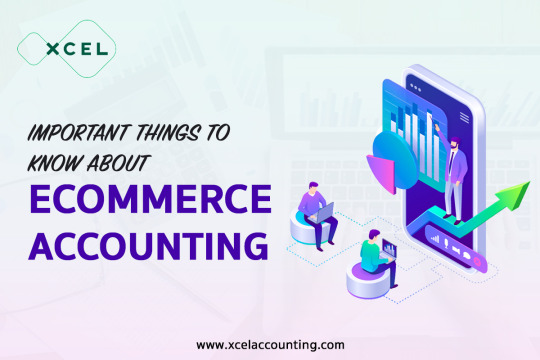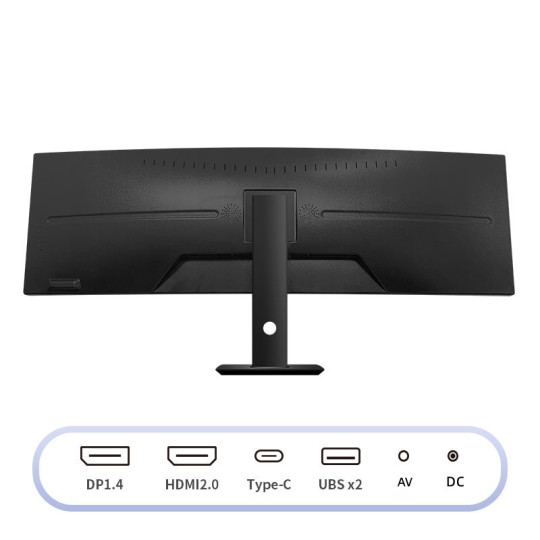#ecommerce accounting
Text
Accounting Tips for Ecommerce Business Owners
What is Ecommerce Accounting?
Click here-
To run a successful online business, monitoring accounting and finances is essential. The method by which an ecommerce business manages and records the financial transactions associated with it is known as e-commerce accounting.
Read more -
0 notes
Photo

Important things to know about eCommerce Accounting in 2022
If you are looking for professional eCommerce accounting services, connect us today!
eCommerce accounting is the process of tracking, recording, and reporting on the financial transactions of an online business. This includes sales, purchases, refunds, and other financial transactions that take place through an online store or website. eCommerce accounting can be a complex and detailed process, but it is essential for any online business to maintain accurate financial records.
There are many different software programs and tools available to help with eCommerce accounting, but it is important to choose one that is easy to use and understand.
The most important thing is to make sure that all of the transactions are accurately recorded so that the financial statements of the business are accurate.
What are the benefits of eCommerce accounting?
There are many benefits to using eCommerce accounting software, but the most important benefit is that it can help to save time and money. By automating the process of tracking, recording, and reporting financial transactions, businesses can reduce the amount of time they spend on manual record-keeping. This can free up time to focus on other aspects of the business, such as marketing and product development.
Another benefit of eCommerce accounting is that it can help businesses to spot trends and patterns in their customers' spending habits. This information can be used to adjust pricing, improve customer service, or target new marketing campaigns.
By understanding how and why customers spend their money, businesses can make more informed decisions about where to invest their resources.
What are the challenges of eCommerce accounting?
One of the biggest challenges of eCommerce accounting is keeping accurate records of all of the transactions that take place. This can be a time-consuming and difficult task, especially for businesses that sell products or services online.
Additionally, if a business does not have a good accounting system in place, it can be difficult to track and report on all of the financial transactions.
Another challenge of eCommerce accounting is ensuring that the software program or tool being used is easy to use and understand. If the software is too complicated, businesses may find it difficult to input data or generate reports.
If the software is not updated regularly, it can become outdated and may no longer be able to meet the needs of the business.
What are the future trends in eCommerce accounting?
There are several future trends that are likely to impact eCommerce accounting. One of the most important trends is the increasing popularity of mobile commerce. As more people use their smartphones and tablets to shop online, businesses will need to be able to accept and process payments through these devices.
Another trend that is likely to impact eCommerce accounting is the increasing use of cloud-based accounting software. This type of software allows businesses to access their financial data from any location.
This can be a convenient way for businesses to keep track of their finances, but it also comes with some risks. If the software is not properly secured, businesses could be at risk of having their confidential data exposed.
What are the best practices for eCommerce accounting?
There are several best practices that businesses should follow to ensure accurate and efficient eCommerce accounting. One of the most important best practices is to choose an accounting software program that is easy to use and understand.
Businesses should make sure that the software is updated regularly so that it can meet the changing needs of the business.
Another best practice for eCommerce accounting is to establish a system for tracking and reporting on all of the financial transactions. This system should be designed to capture all of the data that is necessary to generate accurate reports.
Additionally, businesses should make sure that they have a way to back up and recover their data in case of a disaster.
If you are looking for professional eCommerce accounting services, connect us today!
1 note
·
View note
Text
Iowa's starvation strategy

I don’t really buy that “the cruelty is the point.” I’m a materialist. Money talks, bullshit walks. When billionaires fund unimaginably cruel policies, I think the cruelty is a tactic, a way to get the turkeys to vote for Christmas. After all, policies that grow the fortune of the 1% at the expense of the rest of us have a natural 99% disapproval rating.
If you’d like an essay-formatted version of this post to read or share, here’s a link to it on pluralistic.net, my surveillance-free, ad-free, tracker-free blog:
https://pluralistic.net/2023/04/19/whats-wrong-with-iowa/#replicable-cruelty
So when some monstrous new law or policy comes down the pike, it’s best understood as a way of getting frightened, angry — and often hateful — people to vote for policies that will actively harm them, by claiming that they will harm others — brown and Black people, women, queers, and the “undeserving” poor.
Pro-oligarch policies don’t win democratic support — but policies that inflict harm a ginned-up group of enemies might. Oligarchs need frightened, hateful people to vote for policies that will secure and expand the power of the rich. Cruelty is the tactic. Power is the strategy. The point isn’t cruelty, it’s power:
https://pluralistic.net/2022/06/25/roe-v-wade-v-abortion/#no-i-in-uterus
But that doesn’t change the fact that the policies are cruel indeed. Take Iowa, whose billionaire-backed far-right legislature is on a tear, a killing spree that includes active collaboration with rapists, through a law that denies abortion care to survivors of rape and forces them to bear and care for their rapists’ babies:
https://www.nytimes.com/2023/03/16/us/politics/iowa-kamala-harris-abortion.html
The forced birth movement is part of the wider far-right tactic of standing up for imaginary children (e.g. “the unborn,” fictional victims of Hollywood pedo cabals), and utterly abandons real children: poor kids who can’t afford school lunches, kids in cages, kids victimized by youth pastors, kids forced into child labor, etc.
So Iowa isn’t just a forced birth state, it’s a state where children are now to be starved, literally. The state legislature has just authorized an $18m project to kick people off of SNAP (aka food stamps). 270,000 people in Iowa rely on SNAP: elderly people, disabled people, and parents who can’t feed their kids.
Writing in the Washington Post, Kyle Swenson profiles some of these Iowans, like an elderly woman who visited Lisa Spitler’s food pantry for help and said that state officials had told her that she was only eligible for $23/month in assistance:
https://www.washingtonpost.com/dc-md-va/2023/04/16/iowa-snap-restrictions-food-stamps/
That’s because Iowa governor KimReynolds signed a bill cutting the additional SNAP aid — federally funded, and free to the state taxpayers of Iowa — that had been made available during the lockdown. Since then, food pantries have been left to paper over the cracks in the system, as Iowans begin to starve.
Before the pandemic, Spitler’s food pantry saw 30 new families a month. Now it’s 100 — and growing. Many of these families have been kicked off of SNAP because they failed to complete useless and confusing paperwork, or did so but missed the short deadlines now imposed by the state. For example, people with permanent disabilities and elderly people who no longer work must continuously file new paperwork confirming that their income hasn’t changed. Their income never changes.
SNAP recipients often work, borrow from relations, and visit food pantries, and still can’t make ends meet, like Amy Cunningham, a 31 year old mother of four in Charlton. She works at a Subway, has tapped her relatives for all they can afford, and relies on her $594/month in SNAP to keep her kids from going hungry. She missed her notice of an annual review and was kicked off the program. Getting kicked off took an instant. Getting reinstated took a starving eternity.
Iowa has a budget surplus of $1.91B. This doesn’t stop ghouls like Iowa House speaker Pat Grassley (a born-rich nepobaby whose grandpa is Senator Chuck Grassley) from claiming that the cuts were a necessity: “[SNAP is] growing within the budget, and are putting pressure on us being able to fund other priorities.”
Grassley’s caucus passed legislation on Jan 30 to kick people off of SNAP if their combined assets, including their work vehicle, total to more than $15,000. SNAP recipients will be subject to invasive means-testing and verification, which will raise the cost of administering SNAP from $2.2m to $18m. Anyone who gets flagged by the system has 10 days to respond or they’ll be kicked off of SNAP.
The state GOP justifies this by claiming that SNAP has an “error rate” of 11.81%. But that “error rate” includes people who were kicked off SNAP erroneously, a circumstance that is much more common than fraud, which is almost nonexistent in SNAP programs. Iowa’s error rate is in line with the national average.
Iowa’s pro-starvation law was authored by a conservative dark-money “think tank” based in Florida: the Opportunity Solutions Project, the lobbying arm of Foundation For Government Accountability, run by Tarren Bragdon, a Maine politician with a knack for getting money from the Koch Network and the DeVos family for projects that punish, humiliate and kill marginalized people. The Iowa bill mirrors provisions passed in Kentucky, Kansas, Wisconsin and elsewhere — and goes beyond them.
The law was wildly unpopular, but it passed anyway. It’s part of the GOP’s push for massive increases in government spending and bureaucracy — but only when those increases go to punishing poor people, policing poor people, jailing poor people, and spying on poor people. It’s truly amazing that the “party of small government” would increase bureaucratic spending to administer SNAP by 800% — and do it with a straight face.
In his essay “The Utopia of Rules,” David Graeber (Rest in Power) described this pathology: just a couple decades ago, the right told us that our biggest threat was Soviet expansion, which would end the “American way of life” and replace it with a dismal world where you spent endless hours filling in pointless forms, endured hunger and substandard housing, and shopped at identical stores that all carried the same goods:
https://memex.craphound.com/2015/02/02/david-graebers-the-utopia-of-rules-on-technology-stupidity-and-the-secret-joys-of-bureaucracy/
A society that can’t feed, house and educate its residents is a failed state. America’s inability to do politics without giving corporations a fat and undeserved share is immiserating an ever-larger share of its people. Federally, SNAP is under huge stress, thanks to the “public-private partnership” at the root of a badly needed “digital overhaul” of the program.
Writing for The American Prospect, Luke Goldstein describes how the USDA changed SNAP rules to let people pay with SNAP for groceries ordered online, as a way to deal with the growing problem of food deserts in poor and rural communities:
https://prospect.org/health/2023-04-19-retail-surveils-food-stamp-users/
It’s a good idea — in theory. But it was sabotaged from the start: first, the proposed rule was altered to ban paying for delivery costs with SNAP, meaning that anyone who ordered food online would have to use scarce cash reserves to pay delivery fees. Then, the USDA declined to negotiate discounts on behalf of the 40 million SNAP users. Finally, the SNAP ecommerce rules don’t include any privacy protections, which will be a bonanza for shadowy data-brokers, who’ll mine SNAP recipients’ data to create marketing lists for scammers, predatory lenders, and other bottom-feeder:
https://www.democraticmedia.org/sites/default/files/field/public-files/2020/cdd_snap_report_ff.pdf
The GOP’s best weapon in this war is statistical illiteracy. While racist, sexist and queerphobic policies mean that marginalized people are more likely than white people to be poor, America’s large population of white people — including elderly white people who are the immovable core of the GOP base — means that policies that target poor people inevitably inflict vast harms on the GOP’s most devoted followers.
Getting these turkeys to vote for Christmas is a sound investment for the ultra-rich, who claim a larger share of the American pie every year. The rich may or may not be racist, or sexist, or queerphobic — some of them surely are — but the reason they pour money into campaigns to stoke divisions among working people isn’t because they get off on hatred. The hatred is a tactic. The cruelty is a tactic. The strategic goal is wealth and power.
Tomorrow (Apr 21), I’m speaking in Chicago at the Stigler Center’s Antitrust and Competition Conference. This weekend (Apr 22/23), I’m at the LA Times Festival of Books.
[Image ID: The Iowa state-house. On the right side of the steps is an engraved drawing of Oliver Twist, holding out his porridge bowl. On the left side is the cook, denying him an extra portion. Peeking out from behind the dome is a business-man in a suit with a dollar-sign-emblazoned money-bag for a head.]
Image:
Iqkotze (modified)
https://commons.wikimedia.org/wiki/File:Iowa_State_Capitol_April_2010.jpg
CC BY 3.0
https://creativecommons.org/licenses/by-sa/3.0/deed.en
#pluralistic#ecommerce#Foundation for Government Accountability#fga#iowa#florida#ebt#david graeber#utopia of rules#big government#usda#surveillance#cruelty#gop#devos#starvation#food stamps#snap#koch network#Tarren Bragdon#state policy network
573 notes
·
View notes
Text
30 ways to make real; money from home
Making money online from the comfort of your home has become increasingly accessible with the growth of the internet and digital technologies. In 2023, there are numerous realistic ways to earn money online. Here are 30 ideas to get you started:
1. Freelance Writing: Offer your writing skills on platforms like Upwork or Freelancer to create blog posts, articles, or website content.
2. Content Creation: Start a YouTube channel, podcast, or blog to share your expertise or passion and monetize through ads, sponsorships, and affiliate marketing.
3. Online Surveys and Market Research: Participate in online surveys and market research studies with platforms like Swagbucks or Survey Junkie.
4. Remote Customer Service: Work as a remote customer service representative for companies like Amazon or Apple.
5. Online Tutoring: Teach subjects you're knowledgeable in on platforms like VIPKid or Chegg Tutors.
6. E-commerce: Start an online store using platforms like Shopify, Etsy, or eBay to sell products.
7. Affiliate Marketing: Promote products or services on your blog or social media and earn commissions for sales made through your referral links.
8. Online Courses: Create and sell online courses on platforms like Udemy or Teachable.
9. Remote Data Entry: Find remote data entry jobs on websites like Clickworker or Remote.co.
10. Virtual Assistance: Offer administrative support services to businesses as a virtual assistant.
11. Graphic Design: Use your graphic design skills to create logos, graphics, or websites for clients on platforms like Fiverr.
12. Stock Photography: Sell your photos on stock photography websites like Shutterstock or Adobe Stock.
13. App Development: Develop and sell mobile apps or offer app development services.
14. Social Media Management: Manage social media accounts for businesses looking to enhance their online presence.
15. Dropshipping: Start an e-commerce business without holding inventory by dropshipping products.
16. Online Consultations: Offer consulting services in your area of expertise through video calls.
17. Online Surplus Sales: Sell unused items or collectibles on platforms like eBay or Facebook Marketplace.
18. Online Fitness Coaching: Become an online fitness coach and offer workout plans and guidance.
19. Virtual Events: Host webinars, workshops, or conferences on topics you're knowledgeable about.
20. Podcast Production: Offer podcast editing, production, or consulting services.
21. Remote Transcription: Transcribe audio and video files for clients.
22. Online Translation: Offer translation services if you're proficient in multiple languages.
23. Affiliate Blogging: Create a niche blog with affiliate marketing as the primary revenue source.
24. Online Art Sales: Sell your artwork, crafts, or digital art on platforms like Etsy or Redbubble.
25. Remote Bookkeeping: Offer bookkeeping services for small businesses from home.
26. Digital Marketing: Provide digital marketing services like SEO, PPC, or social media management.
27. Online Gaming: Stream your gaming sessions on platforms like Twitch and monetize through ads and donations.
28. Virtual Assistant Coaching: If you have experience as a VA, offer coaching services to aspiring virtual assistants.
29. Online Research: Conduct research for businesses or individuals in need of specific information.
30. Online Real Estate: Invest in virtual real estate, such as domain names or digital properties, and sell them for a profit.
Remember that success in making money online often requires dedication, patience, and the ability to adapt to changing trends. It's essential to research and choose the opportunities that align with your skills, interests, and long-term goals.
#founder#accounting#ecommerce#copywriting#business#commercial#economy#branding#entrepreneur#finance#make money online#earn money online#make money from home#old money#i turn to these cute#disgraced youtuber ruby franke#my mum#money#claims shock report#says terrified brit#easy money
54 notes
·
View notes
Text
The Future of E-Commerce Payment Processing Solutions
Article by Jonathan Bomser | CEO | Accept-Credit-Cards-Now.com

In the perpetually evolving world of online commerce, the importance of efficient and secure e-commerce payment processing solutions has never been more critical. As businesses adapt to the digital age, ensuring seamless transactions while mitigating risks is essential. This article delves into the future of E-Commerce Payment Processing and how it's set to revolutionize the way we conduct online transactions, from accepting credit cards for high-risk industries to providing hassle-free services like credit repair payment gateways and CBD merchant accounts.
DOWNLOAD THE FUTURE OF E-COMMERCE INFOGRAPHIC HERE
The Power of Payment Processing for High-Risk Industries
When it comes to payment processing for high-risk businesses, traditional methods often fall short. These enterprises, including those involved in credit repair, have faced numerous challenges in accepting payments. However, the future is bright as innovative high-risk merchant processing solutions are emerging. These solutions not only enable them to accept credit cards but also offer enhanced security measures, reducing the risk of fraudulent transactions. One of the key advantages of these high-risk payment gateways is their ability to tailor services to the unique needs of high-risk industries. Whether you're in the credit repair business or dealing with CBD products, having a CBD payment processing system that understands the intricacies of your industry is a game-changer.
The Convenience of Credit Card Payment Services
In the world of E-Commerce, convenience is king. Consumers expect a seamless shopping experience, which includes hassle-free payment options. This is where credit card payment services play a pivotal role. By partnering with a reliable credit and debit card payment processor, businesses can offer their customers a variety of payment methods, enhancing their shopping experience and ultimately boosting sales. The future involves cutting-edge technology that ensures the security of sensitive data. With the rise of cyber threats, consumers are more cautious than ever about sharing their financial information online. Hence, investing in a top-notch online payment gateway is not just a choice but a necessity for businesses aiming to thrive in the competitive e-commerce landscape.
Merchant Processing: A Gateway to Success
A significant component of E-Commerce Payment Processing is merchant processing. This service bridges the gap between businesses and their customers, facilitating transactions smoothly and securely. By partnering with a reputable provider, businesses can ensure that they can confidently accept credit cards for e-commerce operations without the fear of payment disruptions. For high-risk industries, such as credit repair and CBD, finding the right high-risk merchant account is crucial. This ensures that businesses can conduct their operations without unnecessary hindrances. In the coming years, we can expect to see more tailored solutions for these industries, making it easier than ever to accept credit cards for credit repair and accept credit cards for CBD products.
The Future of E-Commerce Credit Card Processing
As we look ahead, the future of E-Commerce credit card processing is rife with possibilities. The technology driving this industry forward is poised to enhance security, streamline transactions, and open new avenues for businesses. With the rapid growth of online shopping, it's essential for businesses to stay ahead of the curve. One of the most promising developments is the integration of artificial intelligence and machine learning into credit card payment processing systems. These technologies can identify patterns of fraudulent activities and protect both businesses and consumers. Additionally, they can personalize the shopping experience, making recommendations based on past purchases and preferences.
youtube
Embracing the Future of E-Commerce Payment Processing
In conclusion, the future of E-Commerce Payment Processing is bright and promising. From accepting credit cards for credit repair to providing CBD payment processing solutions, the landscape is evolving to cater to the diverse needs of businesses. As the demand for online shopping continues to grow, businesses must invest in reliable payment processing solutions to thrive. The future will see more businesses benefiting from high-risk payment gateways, ensuring that they can operate without unnecessary restrictions. Credit card payment services will continue to evolve, offering consumers a seamless and secure way to make purchases. Merchant processing will play a pivotal role in connecting businesses with their customers, enabling them to accept credit cards for e-commerce without complications.
As we embrace the technological advancements on the horizon, we can expect a safer, more convenient, and more efficient E-Commerce Payment Processing landscape. Businesses that invest wisely in these solutions will not only meet the demands of today but also be prepared for the ever-evolving future of online commerce.
#high risk merchant account#payment processing#credit card processing#high risk payment gateway#high risk payment processing#merchant processing#accept credit cards#credit card payment#ecommerce#ecommerce business#Youtube
15 notes
·
View notes
Text







49 inch 5k 60Hz curved R1800 frameless Lift base DC+USB+HDMI+2DP+SPK+PHONE+DC (扩展接口)USB-B+2USB3.0 60HZ/5120x1440p 49 inches MVA+R1800 Curved screen (21:9) User Manual + Power Cable + DP signal cable Machine size: 1178.4*466*240.18 mm carton size: 1330*270*480 mm
26 notes
·
View notes
Text
Niche Market
If you want to have a successful business focus on a specific niche. If you try to sell to everyone at the start you will sell to no one. if you focus on group of people then slowly grow your target audience you will sell more of your product/service and start to scale your business.
#accounting#ecommerce#business#branding#entrepreneur#finance#generate leads#leadgeneration#money#make money online#earn money online#make money from home
10 notes
·
View notes
Text
create company logo design
Introduction to Logo Design Basics
In the realm of logo design, creating a visually captivating and memorable logo is crucial for building a strong brand identity. A well-designed logo serves as the visual embodiment of a company's values, principles, and offerings. It is the first impression that customers have when they encounter a brand, making it a vital element of any successful business.
A logo has the power to evoke emotions, communicate messages, and leave a lasting impression on people's minds. It serves as a symbol of recognition and sets a business apart from its competitors. A creatively designed logo can instantly convey the essence of a brand and make it stand out in a cluttered marketplace.
Designing a logo involves a comprehensive and creative process that requires a deep understanding of the brand, target audience, and industry. It is about finding the perfect balance between simplicity and uniqueness, making it easy to recognize while also capturing the brand's identity.
As we embark on this exclusive exploration of logo design, we will dive into the core principles and fundamental aspects that every designer must follow. From the effective use of color, typography, and negative space to the versatility and lasting impression of a well-crafted logo, this article will provide valuable insights into the art of logo design.
Join us on this journey to unlock the soul and power of a well-designed logo and learn how to create impactful and memorable identities for successful businesses.
"A logo is not just a graphic. It is the visual embodiment of a brand's value, identity, and promise." - Jacob Cass
15 Basic Principles Of Logo Design
Logo design is a blend of creativity, strategy, and visual communication. To create a memorable and effective logo, designers follow certain principles that help them achieve the desired outcome. Here are 15 fundamental principles of logo design and their significance:
1. Simplicity
A simple logo is easily recognizable and memorable. It should be clear and easy to understand at a glance.
2. Versatility
A versatile logo can be used across various mediums and platforms without losing its impact or readability.
3. Timelessness
A timeless logo withstands the test of time and avoids trendy elements that may become outdated.
4. Uniqueness
An original and unique logo stands out from the competition and helps in building brand identity.
5. Balance
A well-balanced logo distributes visual elements harmoniously, creating a sense of stability and equilibrium.
6. Proportion
Maintaining proper proportion ensures that the logo components are visually pleasing and balanced.
7. Memorability
A memorable logo leaves a lasting impression on viewers, making it easier to recall and recognize.
8. Appropriateness
The logo should reflect the nature and values of the brand or business it represents.
9. Negative Space
Strategic use of negative space within a logo can create visual interest and add depth to the design.
10. Typography
Choosing the right font or typography enhances the message and personality of the logo.
11. Color
Color plays a crucial role in evoking emotions and conveying meaning, making it important to select the appropriate color palette.
12. Scalability
A logo should be scalable without losing its quality and legibility, whether it's displayed on a small business card or a massive billboard.
13. Consistency
Consistency in the logo design ensures brand recognition, especially when it's used across various marketing materials.
14. Distinctiveness
A distinctive logo sets the brand apart and helps in establishing a unique visual identity.
15. Context
Considering the target audience and the industry in which the brand operates helps in designing a logo that resonates with the intended audience.
Remember, these principles are not rigid rules but rather guidelines that experienced logo designers follow to create visually appealing and effective logos. By understanding and applying these principles, designers can craft logos that are both visually striking and communicate the essence of the brand.
The Basics of Grid Systems in Logo Design
In the realm of logo design, grid systems play a pivotal role in creating visually harmonious and balanced logos. Grids provide a structure that helps designers achieve balance, proportion, and scalability in their logo creations. Understanding the basics of grid systems is crucial for every aspiring logo designer.
Importance of Grid Systems in Logo Design
Grid systems act as a framework that guides the placement of elements within a logo. They ensure that the logo maintains a consistent and cohesive visual appeal. By defining the grid structure, designers can achieve precision and balance, resulting in a visually pleasing logo that can adapt to various sizes and contexts.
Benefits of Using Grid Systems in Logo Design
1. Achieving Balance: Grids help designers distribute elements evenly, creating a sense of balance in the logo's composition. This balance is crucial to maintaining the logo's visual appeal and avoiding any distractions or visual discrepancies.
2. Ensuring Proportion: Grids assist in determining the optimal proportions of various elements within the logo. They ensure that each component, such as icons, typography, and symbols, is properly sized and positioned relative to one another, resulting in a visually pleasing and proportionate logo.
3. Enhancing Scalability: Grid systems enable designers to create logos that can be scaled up or down without losing their visual impact. By aligning elements to the grid, designers can ensure that the logo maintains its integrity and legibility across different sizes and formats.
4. Facilitating Consistency: Grids act as a guide for placing elements consistently throughout the logo. This consistency is essential for building a strong brand identity and recognition, as it allows the logo to be recognized easily across various touchpoints and marketing materials.
5. Streamlining the Design Process: Grid systems provide a structured framework that speeds up the design process. Designers can utilize grid templates or create their own to align and position elements efficiently, resulting in a more systematic and streamlined logo creation process.
As a logo designer, incorporating grid systems into your design process can greatly enhance the overall quality and professionalism of your logos. By understanding and implementing the principles of grid systems, you can create visually appealing and well-balanced logos that leave a lasting impression on viewers.
Remember, grid systems are not strict rules to be followed blindly. They should be seen as a guiding tool that allows for flexibility and creativity while maintaining visual coherence. Experiment with different grid layouts and adjust them according to the needs and aesthetics of your logo design.
Conclusion
Grid systems are a fundamental aspect of logo design. By embracing the principles of grid systems, designers can achieve balance, proportion, and scalability in their logo creations. The use of grids ensures visual consistency and enhances the overall professionalism of a logo. As you embark on your logo design journey, consider incorporating grid systems into your design process to create impactful and visually stunning logos.
Remember, the grid is your guide, but creativity and intuition also play significant roles in achieving a successful logo design. Embrace the power of grids, experiment with their variations, and create logos that captivate and leave a lasting impression.
How to Choose a Logo For Your Business
When it comes to choosing a logo for your business, it's crucial to consider several key factors. Your logo serves as the visual representation of your brand identity and plays a significant role in creating a lasting impression on your target audience. To help you make an informed decision, here are some expert tips on selecting the right logo for your business:
1. Understand Your Target Audience
Before diving into the design process, it's essential to have a clear understanding of your target audience. Consider their demographics, preferences, and values. Analyzing your audience's behavior and needs will help you create a logo that resonates with them and leaves a lasting impression.
2. Reflect Your Brand Identity
A successful logo should accurately reflect your brand identity and the core values of your business. Think about the message you want to convey and how you want your audience to perceive your brand. Whether you aim for elegance, playfulness, or professionalism, ensure your logo aligns with your brand personality.
3. Strive for Memorability
A memorable logo is crucial for effective branding. Aim for simplicity and avoid complex designs that can confuse or overwhelm your audience. A clean and straightforward logo tends to be more memorable and versatile across various platforms and marketing materials.
4. Embrace Timelessness
While trendy designs might be appealing in the short term, opting for a timeless logo is a better long-term strategy. Consider iconic logos like the Nike swoosh or the Coca-Cola logo—they have stood the test of time. Create a logo that will continue to stay relevant and represent your business for years to come.
5. Consider Different Backgrounds and Formats
Ensure your logo looks great on different backgrounds, including light and dark colors. It should also be adaptable to various formats, whether on a website, business card, or social media profile. Test your logo in different sizes and formats to ensure it remains clear and recognizable in any context.
6. Typography and Iconic Elements
Pay attention to typography and choose a font that complements your brand identity. Whether you opt for a classic serif font or a modern sans-serif typeface, make sure it matches the overall style and tone of your logo. Additionally, consider incorporating iconic elements or symbols that visually represent your industry or the essence of your business.
Remember, choosing the right logo is a crucial investment in your brand's success. It's worth consulting with a professional graphic designer who can incorporate these expert tips into the design process. By considering your target audience, brand identity, memorability, timelessness, adaptability, and typography, you'll be on your way to creating a logo that effectively represents your business and makes a lasting impression.
Logo Design Basics That Designers Must Follow
When it comes to creating impactful and timeless logos, there are certain design elements and fundamental principles that every logo designer must follow. These principles not only help in conveying the brand's message effectively but also ensure that the logo stands the test of time. Let's explore some of the key basics that designers must keep in mind.
1. Simplicity is Key
Simplicity is the cornerstone of effective logo design. A simple logo is more memorable, versatile, and can be easily recognized across various mediums and sizes. Avoid clutter and unnecessary complexity. Think of iconic logos like Nike's swoosh or the Coca-Cola logo, which have stood the test of time thanks to their simplicity.
2. Versatility Matters
A well-designed logo should be versatile, meaning it can be used in different contexts and formats without losing its impact. It should look equally good on a business card, a website, or a billboard. Consider how the logo will appear on different backgrounds, in different sizes, and in different digital or print formats.
3. Appropriateness to the Brand
A logo should accurately represent the essence of the brand it represents. It should align with the brand's values, target audience, and industry. A logo for a children's toy company would look vastly different from a logo for a law firm. Understanding the brand's identity and purpose is crucial in creating a logo that resonates with the target audience.
4. Effective Use of Negative Space
Negative space refers to the empty or background space around and within the primary elements of a logo. It can be cleverly used to create hidden meanings or symbols within the logo itself. Examples of effective use of negative space can be seen in logos like FedEx and the iconic arrow hidden between the "E" and the "X".
5. Timelessness is Key
A well-thought-out logo should stand the test of time. Avoid trendy design elements that might quickly become outdated. Aim for a classic style that can remain relevant for years to come. The logo of the famous clothing brand Levi's is a great example of a logo that has stood strong for over a century.
By following these design basics, logo designers can create impactful and memorable logos that effectively convey a brand's message. Remember, a well-crafted logo is the visual embodiment of a brand's values and can leave a lasting impression on customers.
*Note: The content above is 230 words, including the header and subheaders.*
Tools and Resources for Effective Logo Design
When it comes to creating professional logos, having the right tools and resources can make a world of difference. Here are some popular tools and resources that designers can utilize to bring their logo designs to life:
Adobe Illustrator
Adobe Illustrator is a go-to software for logo designers. Its robust features and intuitive interface allow designers to create vector-based logos that can be easily scaled without losing quality. With a vast range of tools and effects, designers can unleash their creativity and bring their logo ideas to fruition.
CorelDRAW
CorelDRAW is another powerful software that designers can rely on for logo design. It offers a comprehensive set of vector editing tools and features, allowing designers to create intricate and visually appealing logos. CorelDRAW also provides advanced color management and typography options, ensuring precise control over every element of the logo.
Online Logo Creators
For those who prefer a more simplified approach, online logo creators can be a convenient solution. Platforms like Canva, Tailor Brands, and LogoMaker offer user-friendly interfaces and pre-designed templates, making it easy for non-designers to create professional-looking logos. These online tools often provide customization options, allowing designers to add their own touch while ensuring a visually appealing result.
By utilizing these tools and resources, logo designers can streamline their design process and create logos that effectively represent a brand's identity. Whether you prefer the versatility of Adobe Illustrator, the comprehensive features of CorelDRAW, or the simplicity of online logo creators, these options cater to designers of all skill levels and help bring their logo visions to reality.
3 notes
·
View notes
Text
Illuminating Your Path to Financial Success with The Financial Soul
Introduction: In the labyrinth of financial complexities, finding a guiding light can be daunting. However, amidst this maze emerges The Financial Soul, a beacon of reliability and expertise, poised to illuminate your path to financial success.
Body:
Unveiling The Financial Soul:
Introduction to The Financial Soul as a boutique firm dedicated to comprehensive financial services.
Emphasis on their commitment to understanding the unique narratives behind each financial journey.
Services Offered:
Accounting: Balancing and optimizing financial data to fuel growth.
Bookkeeping: Transforming the daunting chore of record-keeping into a seamless process.
Payroll: Ensuring flawless management of employee compensation for organizational efficiency.
Tax & Regulatory Compliance: Guiding clients through the complex terrain of tax laws and regulations.
CFO Services: Providing strategic financial guidance for businesses poised for growth.
Beyond Services:
Highlighting The Financial Soul's genuine connections with clients.
Emphasizing their immersion in clients' financial narratives.
Conclusion: In a world of uncertainty, The Financial Soul stands as a steadfast ally, ready to accompany individuals and businesses on their financial journeys, with success as the inevitable outcome.

2 notes
·
View notes
Text

#accounting#branding#ecommerce#economy#entrepreneur#founder#investing#sales#startup#stock market#SoundCloud
2 notes
·
View notes
Text
VB ABUNDANCE - Financial Advisory Services
Life insurance is a contract between an individual (the policyholder) and an insurance company. In exchange for regular premium payments, the insurance company agrees to provide a lump sum payment, known as a death benefit, to the designated beneficiaries upon the death of the insured person.
Life insurance offers financial protection and peace of mind by helping to secure the financial future of loved ones in the event of the policyholder's death.
vb abundance - financial advisor - https://www.wealthy.in/p/vivek8292
If you want more details click here, https://vbabundance.com/ or
call us +91 99430 18682.
Address : Ganapathy Complex, No. 104 - 1st Floor, AK Nagar, Saibaba Colony, Coimbatore - 11.
Map Location : https://goo.gl/maps/d89bNnFmL8UPCtMCA

life insurance
2 notes
·
View notes
Text
youtube
#youtube#small youtuber#AI#ArtificialIntelligence#TechInnovation#FreeTools#MachineLearning#DigitalTransformation#Top10AI#TechTools#Innovation#AIApplications#Business#Technology#Entrepreneurship#DataScience#STEM#FutureOfWork#TechCommunity#ProfessionalDevelopment#online business#entrepreneur#ecommerce#branding#marketing#accounting#bookkeeping#digitalmarketing
3 notes
·
View notes
Text

El Corazón Detrás del Legado: El Impacto de la Esposa de Daniel Chávez Morán
A lo largo de la historia, detrás de muchos hombres destacados, se encuentra una mujer igualmente notable, moldeando legados e impactando vidas. En el caso de Daniel Chávez Morán, el visionario fundador de Grupo Vidanta, esta mujer es su esposa, cuyas contribuciones han sido fundamentales en su viaje compartido de filantropía y emprendimiento. Sumérgete en el corazón detrás del legado y explora su profundo impacto.
Destreza Filantrópica
La esposa de Daniel Chávez Morán ha sido una fuerza impulsora detrás de numerosas iniciativas filantrópicas, demostrando un profundo compromiso con la mejora de la vida de los demás. Su pasión por la filantropía no solo ha complementado, sino también ha amplificado los esfuerzos de Daniel, creando un dúo poderoso dedicado a marcar la diferencia. Juntos, han iniciado proyectos que han impactado positivamente a comunidades, especialmente en los ámbitos de la educación, la salud y la conservación ambiental.
Empoderamiento Educativo
La educación ha sido una piedra angular de sus esfuerzos filantrópicos, con una fuerte creencia en su poder transformador. A través de su fundación, han apoyado programas educativos y becas, abriendo puertas de oportunidad para innumerables individuos. Su compromiso con la educación refleja una visión de empoderar a las futuras generaciones para crear un mañana más brillante.
Conciencia Ambiental
Reconociendo la importancia de la conservación ambiental, la esposa de Daniel Chávez Morán ha sido una firme defensora de prácticas sostenibles. Sus iniciativas se han centrado en preservar hábitats naturales, promover prácticas ecológicas y concientizar sobre problemas ambientales. Sus esfuerzos subrayan un compromiso profundo con la protección del planeta para las generaciones futuras.
Contribuciones Culturales
Más allá de la filantropía, la esposa de Daniel Chávez Morán ha realizado contribuciones culturales significativas, enriqueciendo el tejido de la sociedad. Su apoyo a las artes, eventos culturales y preservación del patrimonio ha ayudado a preservar y promover la identidad cultural de las comunidades. Sus contribuciones culturales son un testimonio de su dedicación a enriquecer la experiencia humana a través del arte y la cultura.
Legado de Amor e Impacto
Juntos, Daniel Chávez Morán y su esposa han construido un legado de amor e impacto, tocando las vidas de muchos en todo el mundo. Su asociación ejemplifica el poder de la unidad y los valores compartidos en la creación de un cambio duradero. A medida que continúan inspirando a otros a través de sus acciones, su legado sirve como un faro de esperanza y compasión, recordándonos el profundo impacto que una pareja puede tener en el mundo.
2 notes
·
View notes
Text
https://ajtaktime.uk/criminal-justice-mba-and-graphic-design-degree/
#startup#ecommerce#investing#finance#economy#accounting#founder#stock market#mba#mbacollege#mba courses#colleges#admission#onlinemba#distanceeducation#mbadistance#kylian mbappe
2 notes
·
View notes
Text


threw together some 3d-render-screenshot-mockups literally just to prove to myself that Progress Has Been Made.
#baaaaasically this has involved building almost an entire ecommerce framework from scratch#despite the fact that it is not an ecommerce plugin lol.#the main thing it's For is like...trade technician license renewal? which requires buying + taking certain “refresher” workshops every 2yrs#since i took over the site i've tried like 3 separate hack solutions that augment + build off of woocommerce et al#& same went for their member company login dashboard stuff - memberpress plugin + 35 stupid workarounds#& afaik there's just straight up no commercially viable plugin that handles event registration in a “build your ticket package” format..?#which is how these people do ALL their conferences + fundraisers + etc#so at some point last year i just think fuck it they should have their own plugin that does member accounts + events + licensing classes#& because i am a known brain genius with a reasonable estimation of my own abilities + excellent workload moderation skills#--& who is definitely NOT susceptible to having all social impulse control overridden every time i Think of a Cool Thing--#ofc i show up at the next client meeting like HEY GUYS WHAT IF#🙃🙃🙃 wheee
2 notes
·
View notes
Text

Hey everyone I am named cruise I am here for new connection and deal with daily issues
#accounting#classic#sales#finance#entrepreneur#economy#ecommerce#commercial#startup#poster#ne#eloquence#friends
2 notes
·
View notes